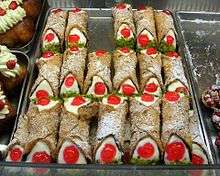Cannoli
Cannoli (Italian pronunciation: [kanˈnɔːli]; Sicilian: cannula) are Italian pastries that originated on the island of Sicily and are today a staple of Sicilian cuisine.[1][2] Cannoli consist of tube-shaped shells of fried pastry dough, filled with a sweet, creamy filling usually containing ricotta. They range in size from no bigger than a finger, to the large versions typically found south of Palermo, in Piana degli Albanesi.[2] In mainland Italy, they are commonly known as cannoli siciliani (Sicilian cannoli).
.jpg) Cannoli topped with chopped pistachios, candied fruit and chocolate chips sprinkled with confectioner's sugar | |
| Type | Pastry |
|---|---|
| Place of origin | Italy |
| Region or state | Sicily |
| Main ingredients | fried pastry dough, ricotta filling |
| Variations | Kannoli (Malta), Kanojët (Albania) |

Etymology
Cannolo is a diminutive of canna, 'cane' or 'tube'.[3]
In Italian, cannoli is grammatically plural; the corresponding singular is cannolo ([kanˈnɔːlo], Sicilian: cannolu), meaning "little tube". In English, cannoli is usually used as a singular, and cannolo is rare.[4]
History
Cannoli come from the Palermo and Messina[5] areas and were historically prepared as a treat during Carnevale season, possibly as a fertility symbol. The dessert eventually became a year-round staple in Sicily.
Some similar desserts in Middle Eastern tradition include Zainab's fingers, which are filled with nuts,[6] and qanawāt, deep fried dough tubes filled with various sweets, which were a popular pastry across the ancient Islamic world. The dish and the name may originate from the Muslim Emirate of Sicily.[7]
See also
References
- Gangi, Robert (2006). "Cannoli". bestofsicily.com. Retrieved 15 May 2014.
- "The Cannoli of Piana degli Albanesi". A Taste of Travel. Retrieved 15 October 2014.
- Oxford English Dictionary, 3rd edition, 2003, s.v.
- Oxford English Dictionary, 3rd edition, 2003 s.v.
- "Scatti di gusto - 30 cannoli siciliani perfetti per un tentativo di classifica definitiva". Scatti di Gusto. Retrieved 15 October 2014.
- Michael Krondl (2011). Sweet Invention: A History of Dessert. Chicago Review Press. p. 102. ISBN 9781556529542.
- Paul H. Freedman (2007). Food: The History of Taste (illustrated ed.). University of California Press. p. 159. ISBN 9780520254763.